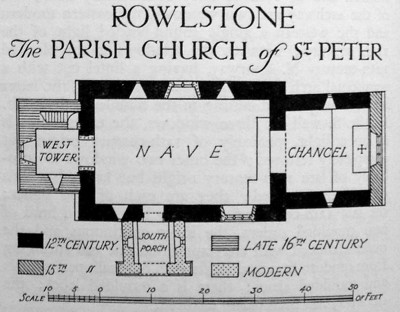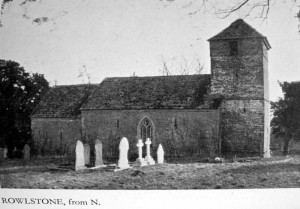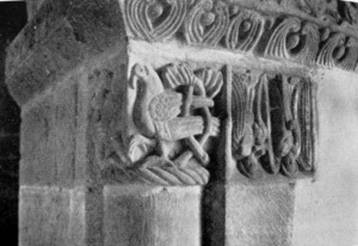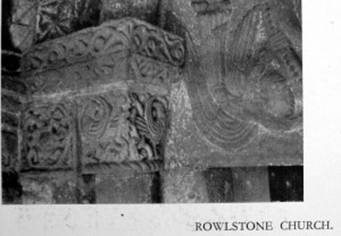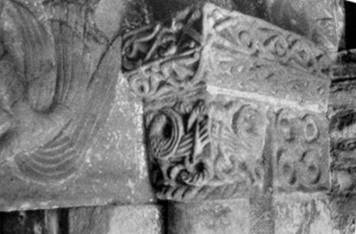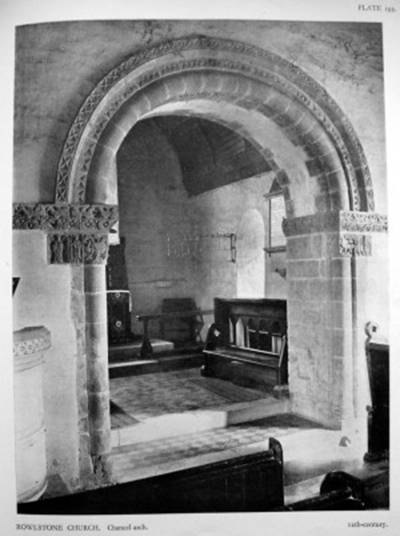Held at: | Hereford Public Library |
Reference: | Royal Commission on Historical Monuments: Herefordshire, Volume 1: H 936.244 |
Source: | Transcript of Original Publication |
Title: | Parish Church of St Peter: architecture, construction and history |
Place name: | Rowlestone |
Date: | Up to 1700 |
Description:
(1). PARISH CHURCH OF ST. PETER (Plate 6) stands in the middle of the parish. The walls are of local sandstone-rubble with worked dressings of the same material; the roofs are covered with stone slates. The Chancel and Nave date from about the middle of the 12th century. It is probable that the E. wall was rebuilt and the chancel shortened in the 15th century, perhaps replacing an earlier apse. The West Tower appears to have been added late in the 16th or early in the 17th century. The church was restored in 1865 and again in 1898, and modern work includes the addition of the South Porch, the extensive rebuilding of the S. wall of the nave and the insertion of some modern windows.
The church is remarkable for the carved 12th-century work in the S. doorway and the chancel-arch, and among the fittings two wrought-iron bracket-candelabra in the chancel are probably unique examples of late 15th or early 16th-century work.
|
Architectural Description—The Chancel (17 ½ ft. by 15 ¼ ft.) has the lower part of the E. wall battered as a plinth. The 15th-century E. window is of three trefoiled lights with trefoiled tracery in a two-centred head. In the N. wall is a small 12th-century window with semi-circular head in one stone. In the S. wall is a similar window, but the head is of a larger stone and has shallow roll-moulding round the arch. The semi-circular chancel-arch (Plates 193, 10) is of mid 12th-century date and is plain on the E. side, and towards the nave has a heavy roll-moulding with a band of diaper-work above; there is also a chamfered label on the W. face with the vertical face enriched with diaper-work; the responds each have an attached shaft on the W. face with a moulded base, and the capital carved with two birds with partly open wings between which and their bodies are intertwined stalks and leaves; the necking is a cable roll; flanking the capitals on the W. face of the wall, and carved out of the same stone as each capital, are square panels each carved in low relief with two figures; the northernmost figure on the N. respond is a nimbed angel, holding in his right hand a short cross, and in his left hand a book ; the southern figure is also nimbed but has no wings, and holds in his right hand a long cross-staff, and in his left hand a book; the corresponding figures to the S. respond are both carved upside down; both are nimbed and the southern figure is also winged; the southern figure holds a book and a scroll, and the northern figure a short cross and a book; the abaci or imposts are chamfered and carved on the inner faces of the responds and towards the nave where they are carried along the wall until they meet the N. and S. walls of the nave. The upper or vertical faces are carved with pairs of birds, face to face and alternating with conventionalised leaves; the chamfered face is carved with pairs of similar leaves with a kind of berry between them, and in one place in each reveal and on the return wall towards the nave, a single bird with its head turned backwards.
The Nave (33 ¾ ft. by 19 ½ ft.) has in the N. wall three windows; the middle window is modern and the two other windows are each of a single 12th-century light with a round head. In the S. wall are two windows, the eastern modern, except for one mullion and the 15th-century traceried head of three trefoiled lights, cut in one stone; the western window is of a single 12th-century light, similar to those in the N. wall but reset; the S. doorway (Plates 194, 10) is of the same date and workmanship as the chancel-arch and has a semicircular arch of two orders, the inner roll-moulded and the outer square and enriched with diaper-ornament ; the grooved and chamfered label is also enriched; the jambs are of two square orders with an attached shaft carrying the inner order of the arch; the shafts have moulded bases and the capitals are each carved with two birds, back to back with intertwining foliage ; flanking the eastern capital and carved out of the same stone is a panel with four enriched rings joined together by beast-heads, while a similar panel flanks the W. capital and is carved with a human mask sprouting foliage which intertwines above the head; the capitals have twisted cable neckings and the chamfered abaci are carved, on both faces, with running foliage; set in the head of the doorway is a tympanum carved with a Majesty; the Christ is seated within a vesica enriched with pellets ; the drapery follows the lines of the figure, the left hand holds a book, and the right is raised in blessing; on either side of and holding the border of the vesica in both hands are two flying angels, heads downwards and with outspread wings; the outer edge of the tympanum has a cable moulding.
The West Tower (8 ¼ ft. square) is of late 16th or early 17th-century date. It rises off a battered plinth topped by a plain roll-moulding and is in three stages surmounted by a pyramidal roof. In the ground-stage the entrance from the nave has a segmental-pointed head; it is completely plastered and is probably modern; in the S. wall is an old rectangular loop and in the W. wall a modern two-light window; the second storey has, in each external wall, a rectangular loop. The second stage has in each wall except the E. a similar loop. The top stage or belfry was probably originally of timber, and the closely spaced vertical studs of oak are now filled in with brick and covered externally with stone walling, which slightly projects beyond the general wall face below.
The Roof of the chancel is of half-round barrel-form divided into panels by early 16th-century moulded ribs; the moulded and embattled wall-plates are of the same date, but the panels are ceiled with modern boarding. The roof to the nave is probably also of the 16th century and is divided into five bays by cambered collar-beam trusses with curved braces; the end-trusses also have tie-beams, the eastern one of which has a notch cut in the middle which may have received the former rood above the chancel; the wall-plates are moulded and embattled. The roof is ceiled with modern boarding. The pyramidal roof of the tower retains some old timbers of 16th or 17th-century date.
Fittings—Altar: a stone slab is used as present altar top, but has no trace of crosses. Bells: three, tenor of 1683 ; 2nd inscribed " Christus via veritas et vita " ; 3rd inscribed " Personet hec celis dulcissima vox Gabrielis " ; both probably 17th century. Brackets : In chancel—on E. wall, on either side of altar, two, of stone, that on N. with lower edge chamfered, that on S. part of coffin-lid reused. Candle Brackets: (Plate 36) In chancel—two, of wrought iron (4 ft. 7 in. long and standing 1 ft. 2 in. away from wall), one on each side wall hung on two iron staples from vertical iron bar against wall forming end of open iron framework consisting of five open rectangular panels with flat upright at outer end terminating in fleurs-de-lis; panels divided by twisted bars rising off horizontal flat bar supported by twisted iron brace or bracket and having in each division iron candle spike; top horizontal member of frame of two bars set on edge with rings between them as stiffeners immediately over candle spikes and acting as supports for candles; upper bars double and ornamented with pairs of flat fleurs-de-lis alternating with pairs of cocks on the N. bracket and swans on the S. bracket, all cut out of sheet-metal, rings below bars to hold candles in place; I5th or early 16th-century. Chest: In W. tower—on second storey, with plain ends, front and back each formed of single plank and lid hinged in two halves with six iron hinges; two broken lock-plates in front, 17th-century. Churchyard Cross : In churchyard—S. of the church, on four steps with mediaeval square to octagonal base with curved broaches, modern shaft and cross. Door: In stair to W. tower, of beaded battens, with two strap-hinges, c. 1700. Floor-slab: In W. tower, to John Morgan, 1711, with later inscriptions below. Font: with circular basin-shaped bowl on circular shaft and modern base; incised cheveron-ornament in four places on upper side of rim; late 12th or early 13th-century. Seating: In W. tower—bench made up of reused material incorporating some 17th-century panelling.
Condition—Good.
|
|
Plate 6 |
|
|
|
Capitals of chancel arch: Plate 10 | Capitals of chancel arch: Plate 10 |
|
|
Capitals of S doorway: Plate 10 | Capitals of S doorway: Plate 10 |
|
|
Plate 193 | Plate 194 |
Observations:
Description documented c 1930 by the Royal Commission on Historical Monuments
Ordnance Survey Map Reference and Index of Parish Properties
Ref: rs_row_0016

